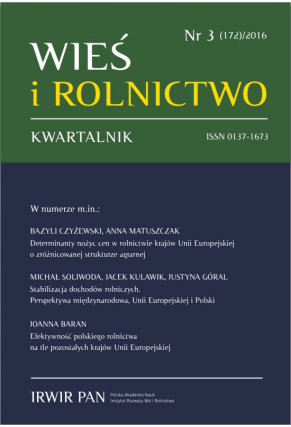Natura 2000 in the Lublin Voivodeship – A Development Barrier or Opportunity for Municipal Government?
DOI:
https://doi.org/10.53098/wir032016/04Keywords:
financial position of local governments, Natura 2000 EEN, economic activity, Lublin voivodeshipAbstract
The aim of the article was to determine the importance of Natura 2000 areas to local development in the Lublin voivodeship. It is hypothesized that the establishment of the European environmental networking programme Natura 2000 (N2000 EEN) resulted in a deterioration of the socio-economic situation of municipalities, as evidenced by the weakening of the income potential of budgets and the willingness of local authorities to invest in the Natura 2000 EEN areas. It is also assumed that protective restrictions have caused a significant need for intervention in the Master Plans of those municipalities. In connection with the above-mentioned assumptions, it has been assumed that the perception of the Natura 2000 network as a barrier to development will be dominant in the surveyed local governments. Literature analysis was used in order to achieve the aim and verify the hypothesis, including the analysis of strategic development documents of the administrative units and the Natura 2000 implementing instruments. It has been shown that the municipalities which included Natura 2000 areas featured a more favorable situation in terms of both the level and the dynamics of their income potential, as compared to other municipalities of the region. The most favorable situation, both in terms of income potential and the tendency to invest, was in the municipalities with a significant share of the Natura 2000 areas. The SWOT analysis has not clearly indicated the importance of Natura 2000 as a barrier, but it has not been seen as a stimulant for development. A small group of municipalities began to use their local natural values as elements of the developing territorial brands. In the light of the presented test results, there is no clear reason to confirm the hypothesis of an adverse effect of the Natura 2000 EEN on the local economy.References
Bołtromiuk A. (2012). Natura 2000 – możliwości i dylematy rozwoju obszarów wiejskich objętych Europejską Siecią Ekologiczną. Problemy Ekorozwoju – Problems of Sustainable Development, 7 (1), 117–128.
Bołtromiuk A., Perepeczko B. (2010). Wpływ obszarów Natura 2000 na rozwój gmin wiejskich – impuls czy hamulec? W: Bołtromiuk A. (red.). Europejska Sieć Ekologiczna Natura 2000 jako nowy element otoczenia polskiej wsi i rolnictwa (s. 17–33). Warszawa: Instytut Rozwoju Wsi i Rolnictwa PAN.
Cent J., M. Grodzińska-Jurczak, A. Pietrzyk-Kaszyńska, J. Gutowska, (2015). Zarządzanie obszarami Natura 2000 w Polsce w kontekście zrównoważonego rozwoju wsi – aktualne wyzwania i konflikty. Wieś i Rolnictwo, 3 (168), 91–106. DOI: https://doi.org/10.53098/wir.2015.3.168/06
Guzal-Dec D., Zwolińska-Ligaj M. (2010). Relacje gmin „naturowych” z otoczeniem w zakresie realizacji koncepcji zrównoważonego rozwoju. W: Bołtromiuk A. (red.). Europejska Sieć Ekologiczna Natura 2000 jako nowy element otoczenia polskiej wsi i rolnictwa (s. 127–141). Warszawa: Instytut Rozwoju Wsi i Rolnictwa PAN.
Koncepcja marki lokalnej i strategia promocji marki gminy Urszulin. Dokument opracowany przez agencję ComPress S.A. na zlecenie Gminy Urszulin. Warszawa 2009.
Lubińska T., Franek S., Będzieszak M. (2007). Potencjał dochodowy samorządów Polsce. Warszawa: Difin.
Pięcek B. (2010). Działalność inwestycyjna gmin objętych siecią Natura 2000. W: Bołtromiuk A. (red.). Europejska Sieć Ekologiczna Natura 2000 jako nowy element otoczenia polskiej wsi i rolnictwa (s. 142–171). Warszawa: Instytut Rozwoju Wsi i Rolnictwa PAN.
Pięcek B. (2011). Sytuacja finansowa gmin objętych siecią Natura 2000 na tle regionu Zielone Płuca Polski i kraju. W: Bołtromiuk A. (red.). Uwarunkowania zrównoważonego rozwoju gmin objętych siecią Natura 2000 (s. 61–97). Warszawa: Instytut Rozwoju Wsi i Rolnictwa PAN.
Rocznik Statystyczny Województw 2014 r. GUS, Warszawa 2015.
Stanicka M., Kałamucka W., Mesuła M. (2013). Rozwój i charakterystyka sieci Natura 2000 na Lubelszczyźnie. Annales UMCS, Geographia, Geologia, Mineralogia et Petrographia, 68 (1), 39–56. DOI: https://doi.org/10.2478/v10066-012-0027-2
Strategia marki Janów Lubelski zoom natury, Janów Lubelski 2013.
Strategia marki Zwierzyniec, http://www.bramyroztocza.pl/static/download/strategia%20Marki%20Zwierzyniec.pdf [dostęp: 04.06.2016].
Strategia rozwoju gminy Józefów na lata 2015–2030, Józefów 2015.
Strategia rozwoju lokalnego Gminy Janów Lubelski na lata 2014–2022, Janów Lubelski 2014.
Strategia rozwoju województwa lubelskiego na lata 2014–2020 (z perspektywą do 2030 r.). Urząd Marszałkowski w Lublinie, Lublin 2014.
Strategiczny Plan Terytorialno-Funkcjonalny w ramach inicjatywy „Aktywne Roztocze” do 2023 r. (Projekt, Lublin–Tomaszów Lubelski, grudzień 2015, http://www.tomaszow-lubelski.pl/upload/files/2016/2016_05/aktywne_roztocze_strategiczny_plan.pdf [dostęp: 04.06.2016].
Zarządzenie Regionalnego Dyrektora Ochrony Środowiska w Lublinie z dnia 12 stycznia 2015 r., publikowane w Dzienniku Urzędowym Województwa Lubelskiego, poz. 182, w sprawie ustanowienia planu zadań ochronnych dla obszaru Natura 2000 Uroczyska Lasów Strzeleckich PLH060099.
Zarządzenie Regionalnego Dyrektora Ochrony Środowiska w Lublinie i Regionalnego Dyrektora Ochrony Środowiska w Rzeszowie z dnia 15 stycznia 2015 r., publikowane w Dzienniku Urzędowym Województwa Podkarpackiego, poz. 179, w sprawie ustanowienia planu zadań ochronnych dla obszaru Natura 2000 Dolina Dolnej Tanwi PLH060097.
Zawora J., Zawora P. (2014). Stan finansów samorządowych u progu nowej perspektywy finansowej Unii Europejskiej na lata 2014–2020. Przedsiębiorstwo i Region, 6, 59–70.
Zegar J.S. (2010). Warunki środowiskowe a ekonomika gospodarstw rolnych. Wieś i Rolnictwo, 1 (146), 106–121. DOI: https://doi.org/10.53098/wir.2010.1.146/06
Zwolińska-Ligaj M. (2013). Przedsiębiorczość na obszarach przyrodniczo cennych województwa lubelskiego. Roczniki Naukowe Stowarzyszenia Ekonomistów Rolnictwa i Agrobiznesu, 15 (4), 473–479.
Zwolińska-Ligaj M. (2015). Functional classification of rural areas in the Lubelskie voivodship including their natural values. Barometr Regionalny, 13 (1), 67–75. DOI: https://doi.org/10.56583/br.965
Źródła internetowe:
Downloads
Article file downloads
Pages
How to Cite
Issue
Section
License
Copyright (c) 2016 Wieś i Rolnictwo

This work is licensed under a Creative Commons Attribution 4.0 International License.










